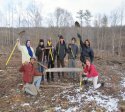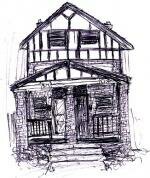Fun with Flat Tires
I’m sitting in TCLR on this Sunday morning, my fingertips slightly blackened with rubber and a blister forming on the heel of my hand. On most Sunday mornings, people hang out in TCLR (Ta Chai Living Room), a public living room with a glorious feature called the Pit in the center. It’s a semi-circular depression in the floor, lined with carpet, the sides angled out such that they’re comfortable to sit back against. Some people hate it, because the carpet is ancient, moldy, and occasionally and inexplicably damp. I like it. It’s cozy. On Sundays people sit around, often quietly reading, writing, or doing computer projects. Sometimes there’s conversation, sometimes silence.
This morning, for my quiet-time activity, I decided to investigate and attempt to fix the flat front tire of one of our nicest public bikes. It’s a blue Schwinn, a road bike, probably from the 90?s. I favored it for all the biking around the farm I do, as did other bike-riding communards, until it “mysteriously” fell out of circulation a few months ago. The “mystery” was that someone rode it to an obscure area, left it on the ground, and forgot about it. Someone else found it overgrown with weeds. I love our bike system–I love that I’ve gotten to try out lots of different styles and sizes of bikes, that there’s almost always a bike available for me to use when I need to make the 1/3 mile trek up to our warehouse on short notice, and most recently I’ve loved going for longer, off-the-farm bike trips with bikes that are everyone’s to use. But the abandoned bike scenario is a drawback.
As I’ve gotten into biking more, I’ve decided it’s a good time to start learning how to maintain and fix bikes. Part of my motivation is the potential need to do simple repairs for myself on the road: all cyclists should know how to fix a flat. But a large part of it is also my enjoyment of learning mechanical skills. And I’m sure Purl, the bikes manager, wouldn’t mind help tackling the pile of broken bikes outside of the bike shop.
My short relationship with bike repair has thus far been different and more fun than my relationship with other mechanical pursuits. For starters, the stakes are very low, even nonexistent. This is contrary to my job of fixing the tofu vacuum packager when it breaks, which is easily my most stressful job. Most of the fixes end up being simple, mechanically; the diagnostic stage is the hard part. The tofu production day stops, and I usually feel like I infect everyone else working in there with tension. The pack honcho asks me what they should do, when to expect the machine to work again. I try to turn my scowl into a weak smile and shrug. If I had other plans for the day, they evaporate; everything takes a back seat to fixing the packager. The only way I have managed to do this job is by doing it with my close friend Calvin, who often succeeds when I’m stymied by simple mechanical obstacles–not being able to loosen stubborn bolts and the like. (Not to mention his excellent problem-solving abilities, which I hope are rubbing off on me.) Other times when I’m involved in fixing machinery, I’m relegated to the “Can you get me the 3/8ths wrench? And the cheater? Not that one, the longer one” position. This has been the case when the tractor has had problems, or helping out with plumbing and building maintenance jobs. I still learn a lot from watching, and I hesitate to ask to do things myself when I worry about messing up and breaking things further. But watching does not help me in the same way as doing.
Which is why I’ve been aiming to do as much fixing of these flat tires as possible, without hands-on assistance from other people (meaning men. I’d be more into working with other women on this). I am very fortunate to have friends who are skilled in bike repair, but who are also sensitive enough to not be intrusive to my projects (thanks DH). Like I said, it’s been really fun. Even with the relatively simple task of flat tire fixes, I’ve failed a number of times already, but I don’t feel any shame over it and there are no negative consequences, except a broken plastic tire lever. It has felt right to try and not fully succeed a few times before soliciting help. The help I’ve gotten has been far more valuable for having become intimately familiar with the problem before learning the solution. Here’s what I’ve learned from my mistakes so far:
–Apply the tube cement over an area on the tube that is definitely larger than the patch.
–Make sure the tube holds air before you put it back in the tire–there might be multiple leaks.
–The tube should be slightly inflated when you’re re-installing it.
–Don’t use tire levers to put the tire back on!
–Unless the last section of tire is being very stubborn. Then, you can carefully use a tire lever, and a metal one may work best. Don’t spend an hour and a half trying to pop the tire back on by hand.
–Oh, and try pumping up the tire before you start the whole process, if you’re not sure the tube is leaky. It might just need air.
I learned the last two this morning in TCLR. The Schwinn’s tire was really narrow and hard to pop back on. After quite a long time trying, I took a break and went to brunch, where I saw DH. I decided I’d struggled with it long enough, and asked DH for tips. He told me it’d probably be ok to use a tire lever. It worked! And I did it all myself. Now I’ll see if the back tire holds air, and if not, I’ll tackle that one too. And then, who knows? Chains, cables, cranks? I like having fun with machines, especially when they’re in my own hands.
- Running in ZK Blog's blog
- Login to post comments
- Feed: Running in ZK
- Original article








